RBSE Solutions for Class 10 Maths Chapter 13 Surface Areas and Volumes Ex 13.4
Rajasthan Board RBSE Solutions for Class 10 Maths Chapter 13 Surface Areas and Volumes Ex 13.4 Textbook Exercise Questions and Answers.
Rajasthan Board RBSE Solutions for Class 10 Maths in Hindi Medium & English Medium are part of RBSE Solutions for Class 10. Students can also read RBSE Class 10 Maths Important Questions for exam preparation. Students can also go through RBSE Class 10 Maths Notes to understand and remember the concepts easily. Make use of our handy algebraic arithmetic sequences calculator and find the Sum of n terms of the arithmetic sequence.
RBSE Class 10 Maths Solutions Chapter 13 Surface Areas and Volumes Ex 13.4
Use π = \(\frac {22}{7}\), unless stated otherwise.
Question 1.
A drinking glass is in the shape of a frustum of a cone of a height of 14 cm. The diameters of its two circular ends are 4 cm and 2 cm. Find the capacity of the glass.
Solution:
According to the question,
Radius of the upper end (R) = 2 cm
Radius of the lower end (r) = 1 cm
Height of glass (H) = 14 cm
The glass is of the shape of a frustum
Volume of frustum = \(\frac{1}{3} \pi\left[\mathrm{R}^{2}+r^{2}+\mathrm{Rr}\right] \mathrm{H}\)
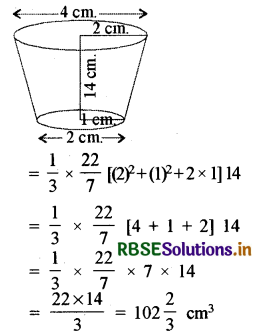
Hence the capacity of the glass = 102\(\frac{2}{3}\) cm3
Question 2.
The slant height of a frustum of a cone is 4 cm and the perimeters (circumference) of its circular ends are 18 cm and 6 cm. Find the curved surface area of the frustum.
Solution:
Slant height of frustum = 4 cm
Let the radii of the upper and lower ends be R and r respectively.
Circumference of the upper end = 18 cm
⇒ 2πR = 18
⇒ R = \(\frac{18}{2 \pi}=\frac{9}{\pi}\) cm
Circumference of the lower end = 6 cm
⇒ 2πr = 6 cm
⇒ r = \(\frac{6}{2 \pi}=\frac{3}{\pi}\) cm
Curved surface area of the frustum = π[R + r] l
= \(\pi\left[\frac{9}{\pi}+\frac{3}{\pi}\right] 4\)
= \(\pi\left[\frac{9+3}{\pi}\right] 4\)
= 12 × 4
= 48 cm2
Hence the curved surface area of the frustum = 48 cm2
Question 3.
A fez, the cap used by the Turks, is shaped like the frustum of a cone (see Fig.). If its radius on the open side is 10 cm, the radius at the upper base is 4 cm and its slant height is 15 cm, find the area of material used for making it.
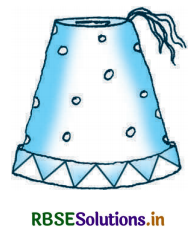
Solution:
According to the question,
Radius of the lower end of the frustum = 10 cm
Radius of the upper end of the frustum (r) = 4 cm
Slant height of the frustum (l) = 15 cm
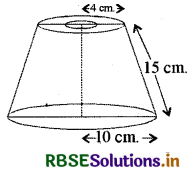
Curved surface of the frustum = πl[R + r]
= \(\frac{22}{7}\) × 15 [10 + 4]
= \(\frac{22}{7}\) × 15 × 14
= 22 × 15 × 2
= 660 cm2
Area of closed end = πr2
= \(\frac{22}{7}\) × (4)2
= \(\frac{352}{7}\) cm2
Area of material used = Curved surface area of the frustum + Area of the closed-end
= 600 + \(\frac{352}{7}\)
= \(\frac{4972}{7}\)
= 710 \(\frac{2}{7}\) cm2
Question 4.
A container, opened from the top and made up of a metal sheet, is in the form of a frustum of a cone of the height of 16 cm with radii of its lower and upper ends as 8 cm and 20 cm, respectively. Find the cost of the milk which can completely fill the container, at the rate of Rs. 20 per litre. Also find the cost of the metal sheet used to make the container, if it costs Rs. 8 per 100 cm2. (Take π = 3.14)
Solution:
According to the question,
Radius of the upper aid of the container (R) = 20 cm
Radius of the lower aid of the container (r) = 8 cm
Height of container (H) = 16 cm
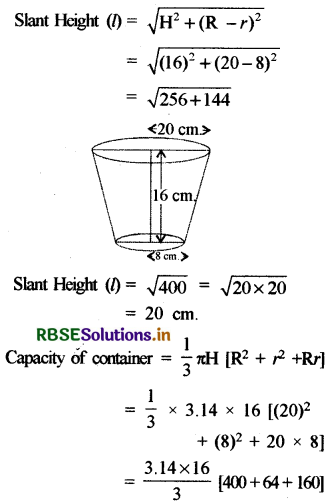
= \(\frac{50.24}{3}\) × 624 cm3
= 50.24 × 208 cm3
∴ Volume of milk in container = 10449.92 cm3 = \(\frac{10449.92}{1000}\) litre
∴ Volume of milk in container = 10.45 litre
Cost of 1 litre = Rs. 20
∴ Cost of 10.45 litres = 20 × 10.45
Cost of milk = Rs. 209
Curved surface area of the frustum = πl [R + r]
= 3.14 × 20 [20 + 8]
= 3.14 × 20 × 28 cm2
= 1758.4 cm2
Area of base of container = πr2
= 3.14 × (8)2
= 3.14 × 64
= 200.96 cm2
Metal sheet used to make the container = Curved surface area of the frustum + Area of base
= (1758.4 + 200.96) cm2
= 1959.36 cm2
∵ Cost of 100 cm2 metal sheet = Rs. 8
∴ Cost of 1 cm2 metal sheet = Rs. \(\frac{8}{100}\)
∴ Cost of 1959.36 cm2 metal sheet = \(\frac{8}{100}\) × 1959.36
= Rs. 156.748
= Rs. 156.75
Hence cost of milk = Rs. 209 and cost of sheet = Rs. 156.75
Question 5.
A metallic right circular cone 20 cm high and whose vertical angle is 60° is cut into two parts at the middle of its height by a plane parallel to its base. If the frustum so obtained be drawn into a wire of diameter \(\frac{1}{16}\) cm, find the length of the wire.
Solution:
According to the question,
Vertical angle of cone = 60°
The altitude of the cone bisects fee vertical angle
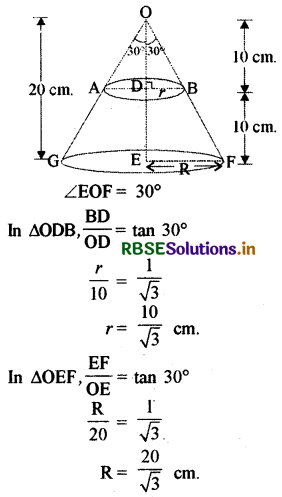
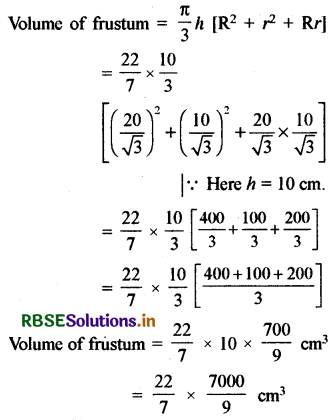
The frustum is drawn into a wire which is of the shape of a cylinder whose diameter is \(\frac{1}{16}\) cm.
∴ Radius of the cylindrical wire = \(\frac{1}{2} \times \frac{1}{16}=\frac{1}{32}\) cm
Let the length of the cylinder thus formed = H cm
∵ On changing the shape the volume remains the same
∴ Volume of frustum = Volume of cylindrical wire
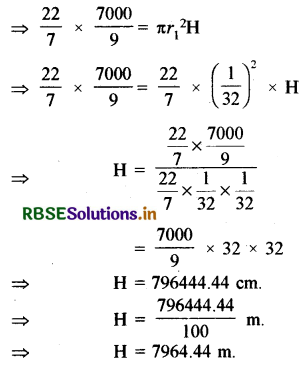
Hence, the length of the cylindrical wire (H) = 7964.4 m

- RBSE Solutions for Class 10 Maths Chapter 6 त्रिभुज Ex 6.3
- RBSE Solutions for Class 10 Maths Chapter 9 त्रिकोणमिति के कुछ अनुप्रयोग Ex 9.1
- RBSE Solutions for Class 10 Maths Chapter 11 रचनाएँ Ex 11.2
- RBSE Solutions for Class 10 Maths Chapter 11 रचनाएँ Ex 11.1
- RBSE Solutions for Class 10 Maths Chapter 8 त्रिकोणमिति का परिचय Ex 8.1
- RBSE Solutions for Class 10 Maths Chapter 7 निर्देशांक ज्यामिति Ex 7.1
- RBSE Solutions for Class 10 Maths Chapter 14 सांख्यिकी Ex 14.3
- RBSE Solutions for Class 10 Maths in Hindi Medium & English Medium
- RBSE Solutions for Class 10 Maths Chapter 15 प्रायिकता Ex 15.2
- RBSE Solutions for Class 10 Maths Chapter 15 प्रायिकता Ex 15.1
- RBSE Solutions for Class 10 Maths Chapter 14 सांख्यिकी Ex 14.4